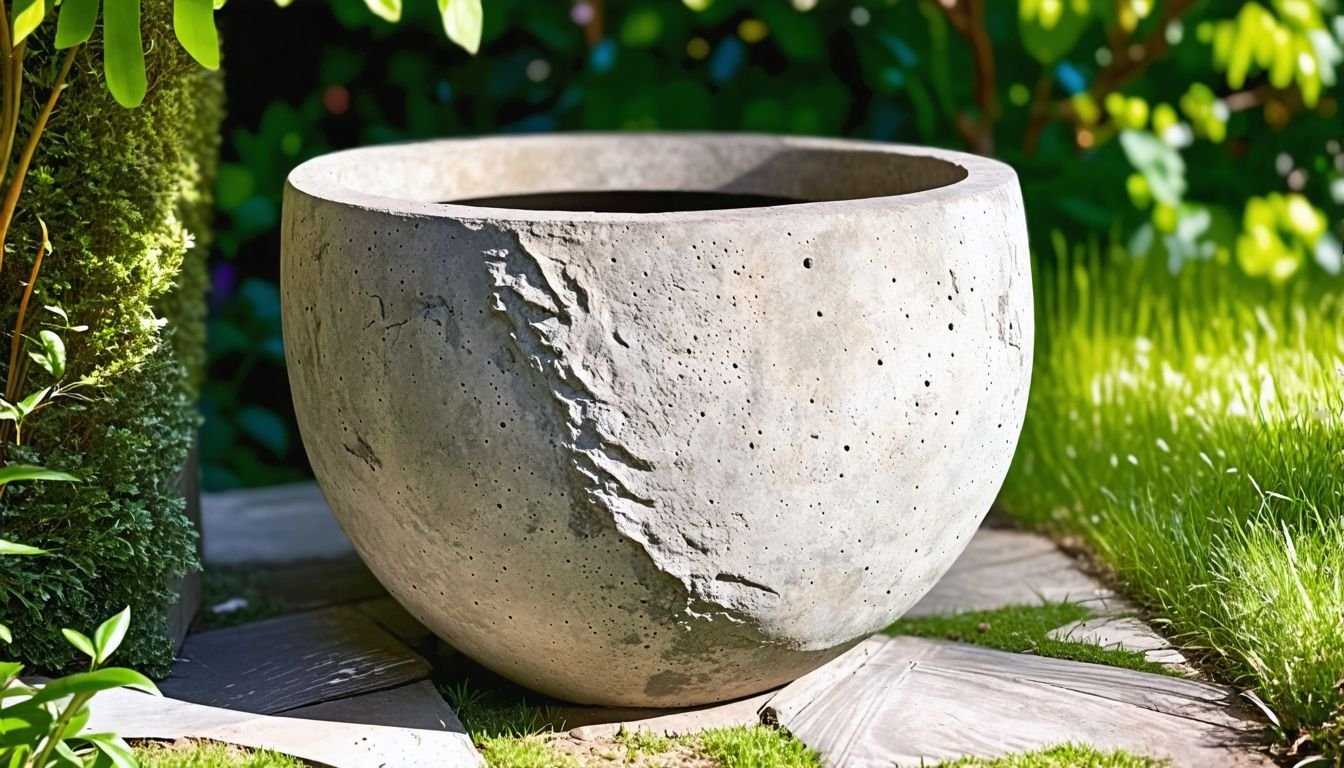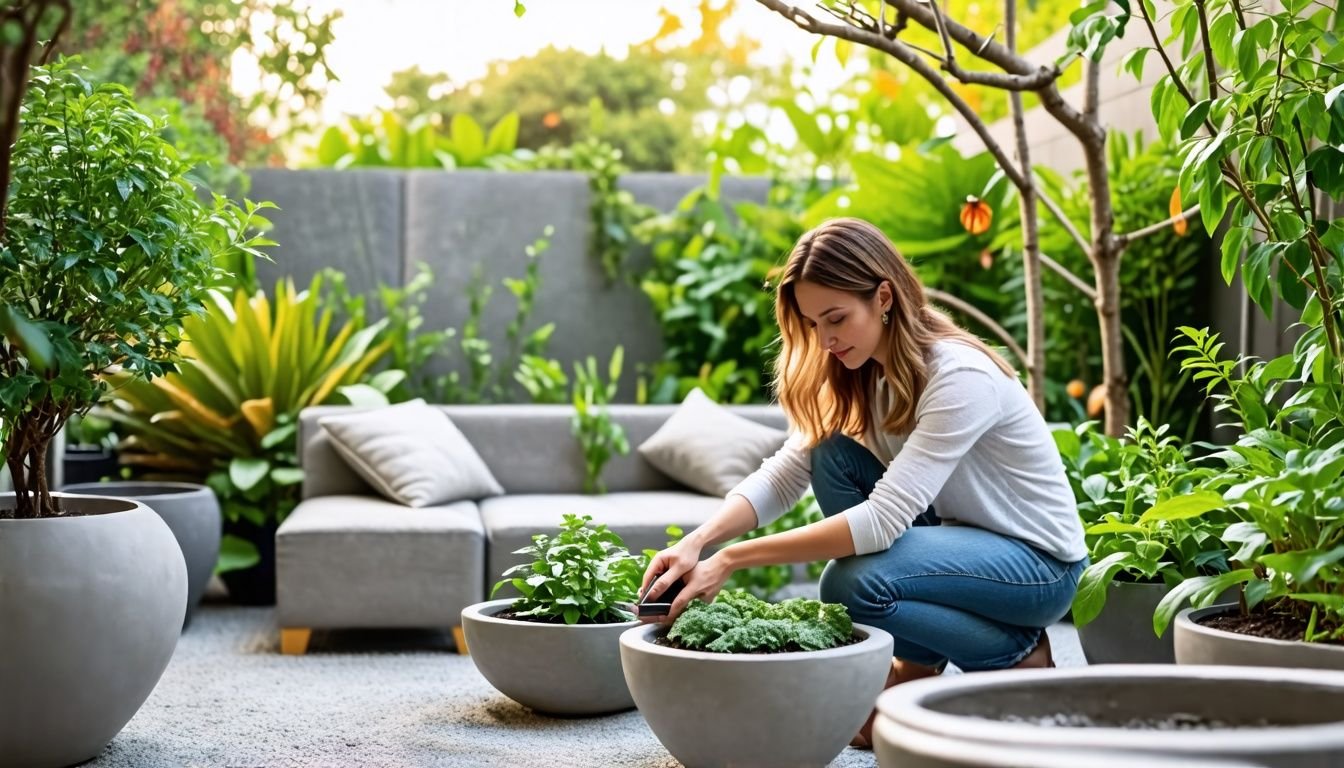Gardens transform homes, turning them into serene outdoor retreats where we can breathe in fresh air and connect with nature. But maintaining lush gardens can be a fair bit of work, what with the watering, weeding, and constant upkeep required.
We’ve all been there, haven’t we? That’s why we researched stylish cement planters. Durable and low-maintenance, they add style without much effort. In fact, concrete planters can last over 20 years with proper care.
This blog shows how cement pots can elevate your garden’s aesthetic. You’ll learn about different planter types like square boxes, troughs and unique shapes. We’ll share design tips for arranging various sizes cohesively and give practical advice on drainage and placement.
By the end, your garden will radiate modern sophistication.
Upgrade your outdoor oasis with sleek, contemporary planters.
Key Takeaways
- Cement planters are durable and low-maintenance, lasting over 20 years with proper care, making them an excellent long-term investment for outdoor spaces.
- A wide variety of cement planter designs, including square boxes, troughs, and unique shapes like Aztec heads or bulldogs, offer versatility to complement any garden style, from modern to traditional.
- Incorporating various sizes and shapes of cement planters and arranging them strategically can create depth, visual interest, and aesthetic appeal in your garden, such as using larger pieces as focal points and smaller accents for depth.
- Ensuring proper drainage by drilling holes, using gravel at the bottom, and elevating planters is crucial for maintaining healthy plants in cement planters.
- Careful handling and placement of heavy cement planters, such as lifting from the bottom, using proper techniques, and choosing level, sturdy surfaces, are essential to prevent damage and ensure safety.
Benefits of Using Cement Planters

Cement planters are outstanding choices for outdoor spaces. They are rock-solid and last ages. Plus, their designs span all styles – modern, traditional, quirky.
Durability and Longevity
One significant advantage of concrete planters is durability. They withstand harsh weather like intense heat, heavy rain, and frost. We never worry about cracks or warping. Concrete withstands the test of time – these planters last decades with minimal maintenance.
Their longevity translates to long-term cost savings. We avoid frequent replacements seen with cheaper alternatives like plastic or timber pots. The initial investment pays off over years of reliable service across greater Melbourne.
Concrete planters are investments that keep giving.
Heavyweight concrete anchors planters firmly, preventing toppling despite strong winds. We appreciate this stability, especially for large specimens or elevated positions. Proper drainage holes allow excess moisture to escape, protecting plant roots.
With sensible care, concrete pots enhance our gardens’ aesthetics for generations.
Versatility in Design
Furthermore, versatility stands as a defining advantage of cement planters. We offer a diverse range encompassing square, rectangular boxes, troughs, large garden boxes and even unique shapes like Aztec heads or bulldogs.
These planters come in various sizes, colours and finishes such as antique terracotta, glazed, lightweight or premium terrazzo. This versatility allows seamless integration into any garden style – be it modern, classical or anything in between.
Crafting aesthetic arrangements becomes effortless with cement planters. We can intermix different sizes and shapes to create visually appealing compositions. Larger pieces provide a striking focal point while smaller accents add depth and interest.
This flexibility opens up endless possibilities for transforming outdoor spaces according to personal tastes. Whether aiming for minimalist chic or an eclectic vibe, cement planters deliver the style we desire.
Popular Types of Cement Planters
Cement planters come in a variety of shapes. Rectangular boxes and troughs are popular choices. [Garden Product] and [Potted Plant] also offer unique designs like [Concrete Sculpture].
Square and Rectangular Boxes
Square and rectangular cement planters offer versatility. We opt for sleek, modern rectangular boxes to define pathways. Square planters create focal points in garden beds. The clean lines complement various design styles.
Crafted from durable concrete, these planters withstand Australia’s harsh conditions. Their timeless aesthetic enhances outdoor spaces for years.
Beauty exists not in opulence but in simplicity. – Alice Morse Earle
We source planters in different sizes at flat rates, ensuring cost-effective delivery across Australia. Our local drivers take care during transportation.
Troughs and Large Garden Boxes
We offer Concrete Troughs and Large Garden Planter Boxes for $195. These spacious planters come in different sizes, ideal for larger planting projects. They create a captivating focal point in gardens.
Many customers use them as vegetable or herb beds.
Troughs and Large Garden Boxes allow homeowners to showcase statement plants. These sturdy concrete containers withstand harsh Australian weather conditions. Their sleek design elevates any outdoor space’s aesthetic appeal.
We recommend incorporating these versatile planters into your landscaping for a polished garden transformation.
Unique Shapes like Aztec Heads and Bulldogs
We offer unique cement planters. They add character to gardens. They are conversation starters. Aztec heads bring history alive. Animal shapes like bulldogs are fun. Delivery cost depends on location.
Delivery drivers bring them safely.
Our garden centres stock Dog in Basket Medium Concrete Planter Statue for $45. They are perfect focal points. Abstract designs create visual interest. Incorporating various shapes enhances aesthetics.
Mix and match for artistic flair.
Arranging planters strategically transforms spaces. Proper drainage ensures plant health. We follow expert tips for maintenance. Explore the versatility of cement planters. Durable material lasts for years.
Design Ideas for Garden Transformation
Garden transformation goes beyond mere visual appeal. Incorporating various planter sizes and shapes creates depth. Arranging planters strategically enhances aesthetics.
Incorporating Various Sizes and Shapes
Mixing various sizes and shapes creates visual appeal. We transform gardens into stunning landscapes.
- Use small concrete pots for compact spaces like balconies or porches. Bonsai pots work wonders for succulents or miniature plants.
- Cube pots make stylish elevations for displaying flowering annuals or perennials. Arrange them in groups for maximum impact.
- Hanging pots suspended from ceilings or trees provide vertical interest. Trailing vines cascade beautifully from these pots.
- Large rectangular troughs become focal points in expansive yards. Plant small trees, shrubs, or an array of herbaceous varieties in these sizeable containers.
- Whimsical shapes like bulldogs or Aztec heads inject fun elements. Kids adore these quirky planters housing their favorite blooms.
- Combine pots of varying heights to create layers. Taller pieces anchor arrangements while smaller ones add pops of colour.
- Mix materials like concrete and terracotta for textural contrast. Juxtaposition of rough and smooth surfaces enhances visual depth.
- Experiment with colour by choosing planters in muted grays, vibrant oranges, or natural earth tones to complement plant life.
- For continuity, repeat same styles in multiple areas. Consistent shapes unify separate garden vignettes seamlessly.
- The $40 Astoria planter and $45 dog basket exemplify budget-friendly options for diverse cement pot choices.
Arranging Planters for Aesthetic Appeal
We love adding stylish cement planters to transform our garden spaces. They offer versatility and design possibilities.
- Vary planter sizes from tiny to massive for visual interest.
- Group planters of similar shapes or materials together.
- Contrast colours and textures between planters and plants.
- Elevate some planters on plinths or pedestals.
- Stagger planter heights from ground level upwards.
- Use large urns or troughs as focal points.
- Repeat round or square planter forms rhythmically.
- Cluster varied planter shapes asymmetrically for a modern aesthetic.
- Guide the eye along paths using lines of similar planters.
- Incorporate whimsical planter sculptures like animal forms.
Maintaining proper drainage will ensure our cement planter investments last.
Practical Tips for Cement Planter Maintenance
Ensuring proper drainage is crucial. Cement planters need holes at the bottom.
Handling and placement demand care. Cement planters are heavy. Consider weights when moving them.
Ensuring Proper Drainage
Proper drainage is vital for healthy cement planters. We ensure our plants thrive by following these steps:
- Drill holes. We drill several holes in the base and sides of cement planters to allow excess water to drain out.
- Use gravel. We layer gravel or crushed rock at the bottom before adding soil to improve drainage.
- Check holes regularly. We inspect drainage holes periodically and clear any blockages caused by soil or roots.
- Elevate planters. We use pot feet or bricks to raise planters slightly off the ground, allowing water to flow out freely.
- Monitor soil moisture. We check soil moisture levels and adjust watering as needed to prevent soggy conditions.
- Replace potting mix. We refresh potting soil annually to maintain good drainage and nutrient levels.
- Consider planter design. We choose planters with built-in drainage features like overflow holes or raised feet.
- Use potting mix amendments. We mix in ingredients like perlite or vermiculite to improve drainage in dense potting mixes.
Handling and Placement
Cement planters are heavy. We must exercise caution when moving them.
- Always lift cement planters from the bottom. Never drag them across surfaces.
- Use proper lifting techniques to avoid injury. Bend knees and keep back straight.
- Assess the planter’s weight before attempting to move it. Get assistance if needed.
- Place cement planters on level, sturdy surfaces like patios or decks. Avoid soft ground.
- Distribute weight evenly within the planter using potting mix and plants.
- Consider installing casters or plant dollies for easier mobility of large planters.
- Allow ample space between planters and structures for access.
- Group planters thoughtfully, paying attention to scale and visual balance.
- Choose planter locations mindful of plant sunlight needs.
- Protect surfaces underneath planters from moisture stains.
Conclusion
Transforming your garden into a stylish oasis has never been easier with cement planters. Their versatility allows you to create aesthetically pleasing arrangements that enhance your outdoor space.
With proper drainage and strategic placement, these durable beauties will thrive for years. Embrace the possibilities and let your creativity blossom – your garden awaits its stunning metamorphosis.
FAQs
1. How do cement planters transform a garden?
Cement planters add style to your outdoor space. They come in various shapes and sizes. You can place them anywhere in your garden. They create focal points and define areas.
2. Are cement planters heavy?
Yes, cement planters are weighty. This makes them stable in windy conditions. They’re great for larger plants. Consider their placement carefully. You might need help to move them.
3. Can I make my own cement planters?
You can craft your own cement planters. It’s a fun DIY project. You’ll need cement mix, moulds, and basic tools. Follow safety precautions when working with cement. There are many online tutorials to guide you.
4. How do I care for plants in cement planters?
Plants in cement planters need proper drainage. Drill holes in the bottom if needed. Use a quality potting mix. Water regularly, as cement can dry out quickly. Choose plants suited to container growing.
